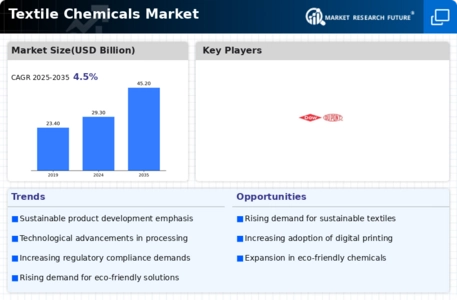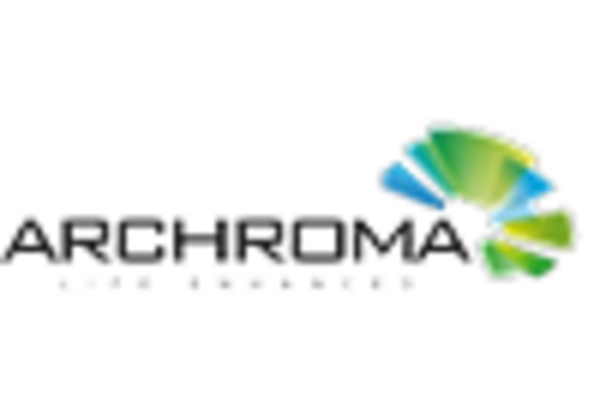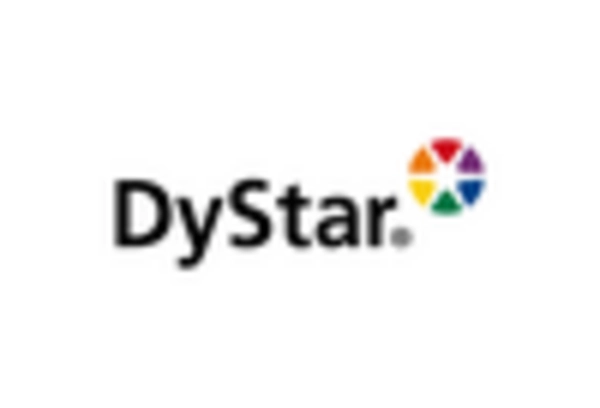Regulatory Compliance
Regulatory compliance is a critical driver influencing the Textile Chemicals Market. Governments and regulatory bodies are implementing stringent regulations regarding the use of hazardous chemicals in textile production. This has prompted manufacturers to invest in safer alternatives and sustainable practices to ensure compliance. The introduction of regulations such as REACH in Europe and similar initiatives in other regions is reshaping the market landscape. Companies that proactively adapt to these regulations are likely to gain a competitive edge, as consumers increasingly favor brands that prioritize safety and environmental responsibility. The Textile Chemicals Market is thus witnessing a shift towards safer chemical formulations, which may lead to increased research and development efforts in the coming years.
Sustainability Initiatives
The increasing emphasis on sustainability within the Textile Chemicals Market is driving demand for eco-friendly chemical solutions. Manufacturers are increasingly adopting sustainable practices, such as using biodegradable materials and reducing water consumption during production. This shift is not merely a trend but a necessity, as consumers are becoming more environmentally conscious. According to recent data, the market for sustainable textile chemicals is projected to grow at a compound annual growth rate of 8.5% over the next five years. This growth indicates a significant transformation in the industry, as companies strive to meet regulatory requirements and consumer expectations for greener products. As a result, the Textile Chemicals Market is likely to witness a surge in innovations aimed at reducing environmental impact.
Technological Advancements
Technological advancements are playing a pivotal role in shaping the Textile Chemicals Market. Innovations in chemical formulations and application techniques are enhancing the performance and functionality of textile products. For instance, the development of nanotechnology in textile chemicals is enabling the creation of fabrics with superior properties, such as water resistance and stain repellency. Furthermore, automation and digitalization in manufacturing processes are improving efficiency and reducing costs. The market is expected to see a rise in the adoption of smart textiles, which integrate technology into fabrics for various applications, including health monitoring and temperature regulation. This trend suggests that the Textile Chemicals Market is on the brink of a technological revolution that could redefine product offerings.
Customization of Chemical Solutions
The demand for customized chemical solutions is emerging as a key driver in the Textile Chemicals Market. As brands seek to differentiate themselves in a competitive landscape, the ability to tailor chemical formulations to specific requirements is becoming increasingly important. This trend is particularly evident in the production of specialty chemicals that cater to niche markets, such as high-performance textiles for sports and outdoor activities. Market data indicates that the segment for specialty textile chemicals is expected to grow significantly, driven by the need for unique properties such as moisture management and UV protection. Consequently, the Textile Chemicals Market is likely to see a rise in collaborations between chemical manufacturers and textile producers to develop bespoke solutions that meet evolving consumer demands.
Rising Demand for Functional Textiles
The rising demand for functional textiles is significantly impacting the Textile Chemicals Market. Consumers are increasingly seeking textiles that offer additional functionalities, such as moisture-wicking, antimicrobial properties, and UV protection. This trend is particularly pronounced in sectors such as sportswear, healthcare, and home textiles. Market analysis suggests that the functional textiles segment is projected to grow at a robust pace, driven by consumer preferences for performance-oriented products. As a result, chemical manufacturers are focusing on developing innovative solutions that enhance the functionality of textiles. This shift indicates that the Textile Chemicals Market is evolving to meet the diverse needs of consumers, potentially leading to new product developments and market opportunities.



 Source: Secondary Research, Primary Research, Market Research Future Database and Analyst Review
Source: Secondary Research, Primary Research, Market Research Future Database and Analyst Review













Leave a Comment